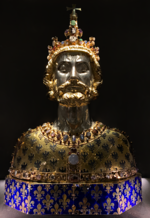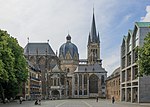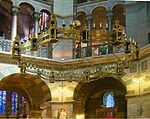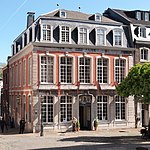Palace of Aachen

The Palace of Aachen was a group of buildings with residential, political, and religious purposes chosen by Charlemagne to be the center of power of the Carolingian Empire. The palace was located north of the current city of Aachen, today in the German Land of North Rhine-Westphalia. Most of the Carolingian palace was built in the 790s but the works went on until Charlemagne's death in 814. The plans, drawn by Odo of Metz, were part of the program of renovation of the kingdom decided by the ruler. Today much of the palace is destroyed, but the Palatine Chapel has been preserved and is considered a masterpiece of Carolingian architecture and a characteristic example of architecture from the Carolingian Renaissance.
Excerpt from the Wikipedia article Palace of Aachen (License: CC BY-SA 3.0, Authors, Images).Palace of Aachen
Ritter-Chorus-Straße, Aachen Burtscheid (Aachen-Mitte)
Geographical coordinates (GPS) Address Nearby Places Show on map
Geographical coordinates (GPS)
| Latitude | Longitude |
|---|---|
| N 50.775555555556 ° | E 6.0838888888889 ° |
Address
Katschhof
Ritter-Chorus-Straße
52062 Aachen, Burtscheid (Aachen-Mitte)
North Rhine-Westphalia, Germany
Open on Google Maps










